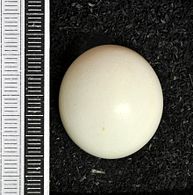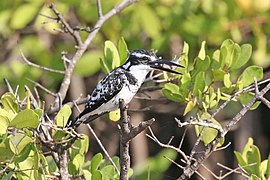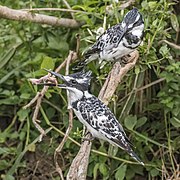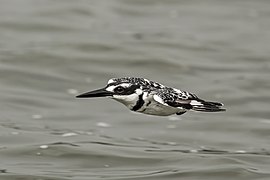Pied kingfisher
| Pied kingfisher | |
|---|---|
| Male | |

| |
| Female both C. r. leucomelanurus Chambal River, Uttar Pradesh, India | |
| Scientific classification | |
| Domain: | Eukaryota |
| Kingdom: | Animalia |
| Phylum: | Chordata |
| Class: | Aves |
| Order: | Coraciiformes |
| Family: | Alcedinidae |
| Subfamily: | Cerylinae |
| Genus: | Ceryle F. Boie, 1828 |
| Species: | C. rudis
|
| Binomial name | |
| Ceryle rudis | |
| Synonyms | |
| |
The pied kingfisher (Ceryle rudis) is a species of water kingfisher widely distributed across Africa and Asia. Originally described by Carl Linnaeus in 1758, it has five recognised subspecies. Its black and white plumage and crest, as well as its habit of hovering over clear lakes and rivers before diving for fish, make it distinctive. Males have a double band across the breast, while females have a single broken breast band. They are usually found in pairs or small family groups. When perched, they often bob their head and flick up their tail.
Taxonomy and evolution
The pied kingfisher was one of the many bird species originally described by Linnaeus in the landmark 1758 10th edition of his Systema Naturae, who noted that it lived in Persia and Egypt. He named it Alcedo rudis.[2] The German naturalist Friedrich Boie erected the genus Ceryle in 1828.[3] The name is from classical Greek kērulos, an unidentified and probably mythical bird mentioned by Aristotle and other authors. The specific epithet rudis is Latin for "wild" or "rude".[4]
The pied kingfisher is the only member of the genus Ceryle. Molecular analysis shows it is an early offshoot of the lineage that gave rise to American kingfishers of the genus
There are five subspecies:[7]
- C. r. syriacus Roselaar, 1995 – Turkey to Israel east to southwest Iran (some ornithologists do not recognise this subspecies)[8][9]
- C. r. rudis (Linnaeus, 1758) – Egypt and Africa south of the Sahara
- C. r. leucomelanurus Reichenbach, 1851 – east Afghanistan through India to south China and north Indochina
- C. r. travancoreensis Whistler, 1935 – southwest India[10]
- C. r. insignis Hartert, 1910 – east and southeast China, Hainan Island
Description
This is a medium-sized kingfisher, about 25 cm (9.8 in) long with a white with a black mask, a white supercilium and black breast bands. The crest is neat and the upperparts are barred in black. Several subspecies are recognized within the broad distribution. The nominate race is found in sub-Saharan Africa, extending into West Asia. The subspecies syriacus is a larger northern bird similar to the nominate subspecies (following Bergmann's rule).[8] Subspecies leucomelanura is found from Afghanistan east into India, Thailand and Southeast Asia. The subspecies travancoreensis of the Western Ghats is darker with the white reduced. The subspecies C. r. insignis is found in Hainan and southeastern China and has a much larger bill. Males have a narrow second breast-band while females have a single broken breast band.[11][12]
-
Egg, collection Museum Wiesbaden
-
Immature male C. r. rudis
Uganda -
female C. r. rudis
the Gambia -
male C. r. rudis
Kazinga Channel, Uganda -
Female C. r. syriacus
Israel -
C. r. rudis eating a fishPilanesberg Game Reserve, South Africa
Distribution
It is common throughout sub-Saharan Africa and southern Asia from Turkey to India to China. It is resident, and most birds do not migrate, other than short-distance seasonal movements.[13] In India it is distributed mainly on the plains and is replaced in the higher hills of the Himalayas by the crested kingfisher (Megaceryle lugubris).[14]
The pied kingfisher is estimated to be one of the three most numerous kingfishers in the world; the other two are the common kingfisher and collared kingfisher. It is a noisy bird, making it hard to miss.[13]
Behaviour
When perched the pied kingfisher often bobs its heads up and down and will sometimes raise its tail and flick it downwards. It calls often with sharp chirruk chirruk notes.[15] Unlike some kingfishers, it is quite gregarious, and forms large roosts at night.[16]
Feeding
This kingfisher feeds mainly on fish, although it will take crustaceans and large aquatic insects such as dragonfly larvae.[17] It usually hunts by hovering over the water to detect prey, before diving vertically bill-first to capture fish. When not foraging, it has a straight rapid flight and have been observed flying at speeds approaching 50 km/h.[18] In
It can consume prey without returning to a perch, often manipulating the subject with its bill and swallowing in flight, and so can hunt over large water bodies or in estuaries that lack perches required by other kingfishers.[20]
Breeding
The breeding season in India is February to April. Its nest is a hole excavated in a vertical mud bank about five feet above water. The nest tunnel is four to five feet deep and ends in a chamber. Several birds may nest in the same vicinity. The usual clutch is three to six white eggs.[21] The pied kingfisher sometimes reproduces cooperatively, with young non-breeding birds from an earlier brood assisting parents or even unrelated older birds.[22] In India, nestlings have been found to be prone to maggot infestations (probably by Protocalliphora sp.)[23] and in some areas to leeches.[24] Nest holes may sometimes be used for roosting.[15]
In 1947, British zoologist Hugh B. Cott noticed while skinning birds that hornets were attracted to certain birds but avoided the flesh of pied kingfishers. This led to a comparative study of edibility of birds and he suggested that more conspicuously plumaged birds may be less palatable. This suggestion was, however, not supported by a subsequent reanalysis of his data.[25][26]
-
Composite showing C. rudis rudis dive, the Gambia
-
A composite image showing the fishing - from hovering to dive
-
C. r. rudis eating fish
the Gambia
References
- . Retrieved 12 November 2021.
- ^ Linnaeus, Carl (1758). Systema Naturae per Regna Tria Naturae, Secundum Classes, Ordines, Genera, Species, cum Characteribus, Differentiis, Synonymis, Locis (in Latin). Vol. I (10th revised ed.). Holmiae: (Laurentii Salvii). p. 116 – via The Internet Archive.
- ^ Boie, Friedrich (1828). "Bemerkungen über mehrere neu Vogelgattungen". Isis von Oken (in German). 21. Col 316.
- ISBN 978-1-4081-2501-4.
- ^ S2CID 84824051.
- .
- ^ Gill, Frank; Donsker, David, eds. (2017). "Rollers, ground rollers & kingfishers". World Bird List Version 7.2. International Ornithologists' Union. Retrieved 17 May 2017.
- ^ S2CID 39575753.
- ^ Woodall, P. F. (2017). del Hoyo, J.; Elliott, A.; Sargatal, J.; Christie, D. A.; de Juana, E. (eds.). "Pied Kingfisher (Ceryle rudis)". Handbook of the Birds of the World Alive. Lynx Edicions. Retrieved 25 May 2017.
- ^ Pittie, A.; Dickinson, E. E. (2010). "Authorship of new names proposed in papers by Whistler & Kinnear, entitled 'The Vernay Scientific Survey of the Eastern Ghats (Ornithological Section)', during 1930–1937" (PDF). Indian Birds. 6 (6): 158–161.
- ISBN 978-849655385-9.
- ^ Peters, J. L. (1955). Check-list of the Birds of the World. Volume 5. Harvard University Press. p. 167.
- ^ ISBN 978-0-7136-8028-7.
- ^ Hutson, H. P. W. (1931). "The Birds of Hong Kong. Part 6" (PDF). Hong Kong Naturalist. 2 (2): 85–89.
- ^ ISBN 9780195659375.
- ^ Sclater, W. L. (1903). The Birds of South Africa. Vol. 3. London: R.H. Porter. pp. 73–76.
- JSTOR 3676115.
- ^ Donald, C.H. (1929). "The speed of the Indian Pied Kingfisher Ceryle rudis leucomelanura". Journal of the Bombay Natural History Society. 33 (1): 204–205.
- S2CID 25284942.
- JSTOR 2402997.
- ^ Hume, A. O. (1890). The nests and eggs of Indian birds. Vol. 3 (2nd ed.). London: R. H. Porter. pp. 8–11.
- S2CID 53202094.
- ^ McCann, C. (1932). "Nestling of the Indian Pied Kingfisher (Ceryle rudis) attacked by larvae of parasitic fly". Journal of the Bombay Natural History Society. 35 (4): 897–898.
- ^ Humayun, Abdulali (1939). "Leeches attacking chicks of the Pied Kingfisher (Ceryle rudis Linn.)". Journal of the Bombay Natural History Society. 41 (1): 173.
- .
- JSTOR 3677074.
Further reading
- ISBN 978-0-19-857507-8.
External links
- Pied Kingfisher Species text in the Atlas of Southern African Birds
- Photos and video














